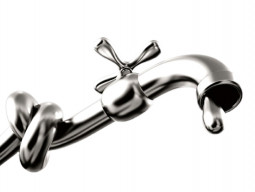
The energy crisis is now on everyone’s mind. It didn’t just show up out of the blue this summer; it has been growing, steadily, over the past decade. Inability to take decisive action, more than anything, is what has brought us to this stage. Even today, nothing by way of structural reform is taking place in the energy sector. Everyone eagerly awaits to see what the next government plans to unveil to tackle this issue. The only other issue that has the potential of dwarfing the energy crisis is a water crisis. How long can we wait, ignoring the symptoms of deep malaise in the domestic water supply and sanitation sector, until the water crisis is too endemic?
Cities and settlements across Pakistan are increasingly facing water quality and sanitation challenges. The Pakistan Council of Research in Water Resources, in its 2007 report on the National Water Quality Monitoring Programme, found unsafe drinking water in, at least, one water source tested in each of the 23 major cities it surveyed (none of the water tested in Bahalwapur, Kasur, Multan, Lahore, Sheikhupura and Ziarat was found safe). Access to clean drinking water is a fundamental right recognised by the Supreme Court of Pakistan.
There are numerous challenges to the provision of clean drinking water and sanitation in cities. Aging infrastructure (old water and sewage pipes often leak, mixing with one another) is a familiar challenge. So is the recognised need to metre and measure water consumption. Both underpin the importance of properly measuring and charging for water consumption. However, rapid urbanisation, overuse and climate change are posing new challenges and require focused coordination between provincial and local governments.
Cities in Pakistan get their drinking water from several sources. Man-made reservoirs, like Rawal Lake that supplies Islamabad and Rawalpindi with water, are one. So is mining the aquifer, as is done in Lahore. Many settlements rely on groundwater drawn from tube-wells and many others on surface water resources such as canals.
Rapid urbanisation has increased the built environment, increasing surface water run-off and reducing the quality of recharge. Recharge of the aquifer is complicated by increased run-off as it is often mixed with chemicals and other pollutants in the catchment. The aquifer itself is under stress. There is no real understanding of the rate at which our cities and settlements are consuming groundwater; there is little appreciation that overconsumption could deplete existing groundwater resources. There is little concern for how polluted recharge could affect every one of us.
The need to act is immediate. Other than the immeasurable cost of human lives, as a result of impure drinking water, the cost associated with poor sanitation is estimated to be 3.8 per cent of GPD (think of the loss of earnings due to time spent away from work; the fact that half the hospital beds in Pakistan today are filled by patients suffering from water-borne ailments; the cost of building and maintaining medical infrastructure; training and paying for doctors and subsidising medicines). And we are recklessly consuming a finite resource. There is little we can expect by way of ‘development’ if such costs continue unaddressed. I should add that the water quality and sanitation situation in rural areas is no better. The further downstream one travels, water-ailments become epidemic.
Cities need to immediately change how they approach the idea of water supply. At the moment, those charged with water and sanitation are concerned about covering their operating costs and are constantly engaged in a cycle of build-neglect-repair. The predominant thinking is that higher user charges and metered connections will solve our problems. While these concerns are valid, they are not the only ones water and sanitation providers should have in mind.
Cities need to secure their water supplies by better understanding their catchments and diversifying their water resources. They need to think beyond capturing rainfall runoff, building water reservoirs and foresting catchments. Alternative sources for cities and settlements include groundwater, urban storm water, rainwater (roof run-off) and recycled wastewater.
Cities need to change the very manner in which they approach water supply. Our cities focus on large and centralised infrastructure. In Lahore, for example, the thinking is that the city needs one or two waste-treatment plants. These plants are to be so big that the government has spent decades negotiating with foreign donors. And while the negotiations continue, the city continues to discharge all of its untreated domestic and industrial waste into the River Ravi. Lahore needs to start thinking of decentralised integrated solutions. There is no other way of diversifying water resources.
Steps need to be taken immediately; else the worst-case scenario might become a reality: we will begin to run out of potable water. Unlike electricity, water cannot be ‘produced’; it is a finite resource. Without water, there can be no life. No other issue in Pakistan is this important.
Published in The Express Tribune, May 26th, 2013.
COMMENTS (6)
Comments are moderated and generally will be posted if they are on-topic and not abusive.
For more information, please see our Comments FAQ




























































But how will MNC's which offer jobs to our aspiring middle-upper classes make money selling bottled water if clean water is available to all?
Dear Rafay Sahib,
I appreciate you always raise such issues which are gradually swallowing us up without being noticed. Yes, we also face these issues other than corruption/terrorism detrimental to our survival. I know your identified issues will not stir much interest among Pakistanis; as their one and only problem is "corruption of civilian Politicians". rolled eyes.
The reality is world doesn't really have a energy crisis. We have a energy deficit, that'll be bridged within a decade+
It is expected that Solar energy will become cheaper than Natural Gas within this decade, and continuing drop in prices of Solar PV will make Solar energy price cheaper than most other sources of energy (perhaps including Hydro).
But, water is a more precious commodity. There isn't sufficient potable water to feed/satiate the world population, with current level of consumption or sanitation tech.
What is needed is revolution in sanitation technology, that makes it possible for people to live comfortably on 1/4th water consumption of today.
Should cities consider ban on urban migration "sans raison"? Should this country ( thats Pakistan for the uninitiated) develop more profit centres like lahore , faisalabad, karachi etc.?
"Pakistan loses 3.9% GDP due to inadequate sanitation" - http://dawn.com/2012/04/13/inadequate-sanitation-costs-pakistan-rs-343-7-bln/
Overall a well written and thoughtful article. I do question the 3.8% impact on GDP by unsafe drinking water. If you add the supposed 3% loss to GDP due to load shedding and another 3% loss to GDP due to terrorism and law and order problems and another 2% due to illiteracy and lack of adequate skills, one would conclude that a country like Australia where these problems do not exist would be growing at least by 11.8% and if these problems were solved, Pakistan would grow by 15% (3.2% current growth plus the 11.2% opportunity loss it currently suffers)